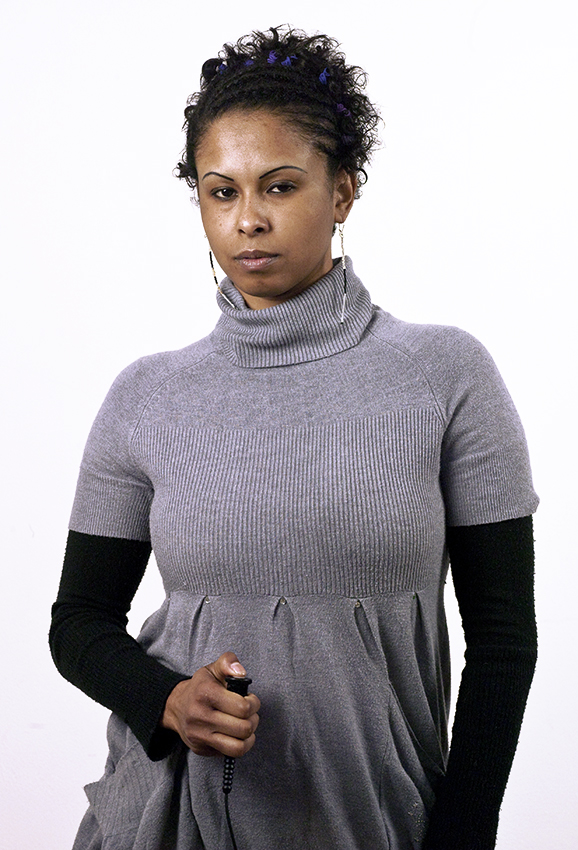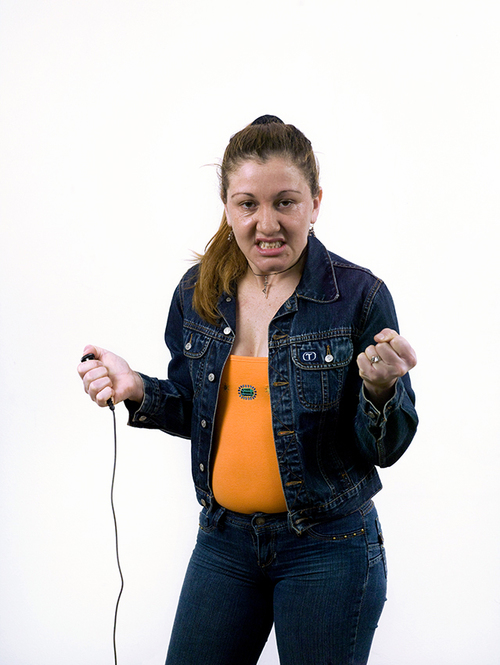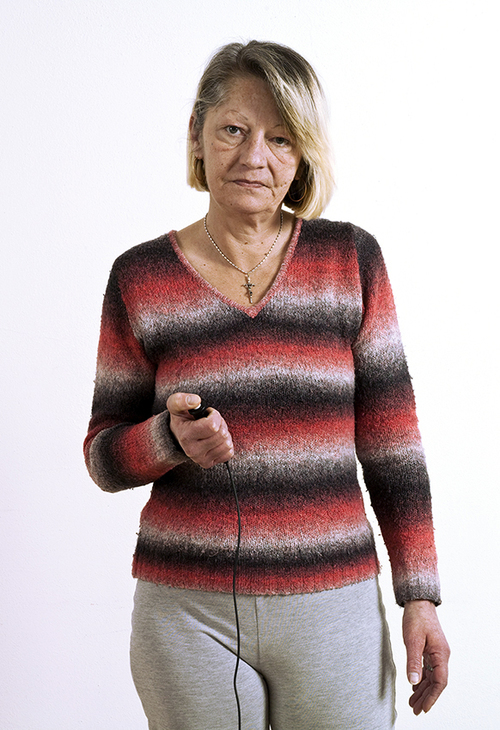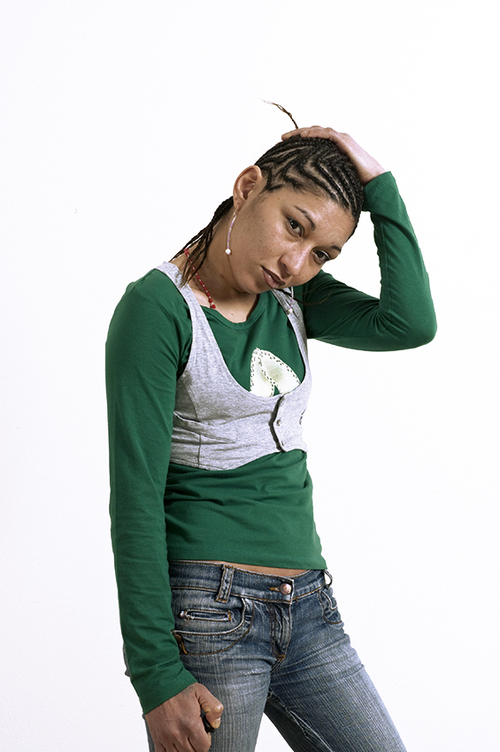
 Being convinced that the self-portrait is the portrait of
Being convinced that the self-portrait is the portrait of
our “higher self”, and after my
experience at Lucca’s Mental Health Center last year, I really wanted to hold a workshop
in prison. I wanted to prove that in essence, every human being is divine and perfect,
following Spinoza’s vision. I wanted woman inmates to experiment the self-portrait in
my studio, to let go of the most difficult emotions in order to enter their “cavern”. I
wanted
to help them discover their own greatness, to improve their self-image or at least, to help
them perceive themselves as multi-faceted, so that they
would not remain “imprisoned”
forever under the label “outcast”, “criminal”. If we managed to do this, they could have
more possibilities to transform
their lives.
Amazingly Milan’s prison San Vittore’s director
immediately accepted my request, so
Fiorella Minetti, professional educator, and me started the workshop at the end of
February this year. Fiorella and Iwent into the women’s prison, the heavy iron doors
closing behind us, to hold the presentation. We didn’t know how many would want to
participate. I was very nervous because I really wanted to be accepted by them.
When they started to enter the room I felt better, they
smiled at me, and looked curious
and friendly. I started by telling them my whole story (see “About being seen” in this blog)
to state that I could have been in their place and I felt lucky, so I had to give something
back. I also
said it felt weird at teaching them anything, because being in prison they had
access to a kind of knowledge and wisdom I didn’t have.
They all signed up for the workshop, although not all of
them were allowed to participate.
Two days later we were there again, with my strobe lights, Mamiya ZD and computer. We
held a two day workshop on the
expression of emotions, and since all participants were
enthusiastic and wanted to continue, we finally held the complete workshop, which ended
in July.
We were deeply moved by the results. In the
pictures we saw pain and suffering, but also
inner strength, deep thought,
responsibility for what they’ve done and the determination to
never give up.
They all showed a capacity to be in touch with their inner selves. I must say
that I see no big difference from other people’s self-portraits. Maybe in
these series there
is less concern for external appearance, and more energy in
the expression of emotions.
But ultimately, in the self-portrait, we are very
similar.
Unfortunately the prison administration did not authorise
the publication of the body exercise
self-portraits because the inmates were
on topless. All the women agreed to show these
pictures, because they knew
they carried important statements: they were the pure expression
of emotions,
of the human soul. These women also realized that the body self-portraits
allowed
them to open up, to express themselves fully and to really get in
touch with their most intimate
selves. I think we need to restore the naked
body’s expressive value, in response to its
objectification in meaningless
images with which we are constantly bombarded. I hope I will be
able to
publish them in my book next year.
C.R.
C.R.’s image (above) is emblematic of our whole
workshop. We were told that C.R. was very
rebellious and actually she was not
allowed to participate to the group work on the images on
the second day, and
we never saw her again after that, since she had been sent to a punitive
prison. Although the rest of the women were angry at her, I personally believe
that her rebellion
expressed the whole group’s desire and need for rebellion.
Yes, need: if we are in prison, we
probably need to rebel to feel somehow
free.
By producing this wonderful work she also acted as a
speaker of the group of women inmates.
They all chose this picture
unanimously, and some said it represented “mea culpa” or the
assumption of
responsibility, and the pain for what she’d done. In a prison where most
inmates
are waiting for trial, this seemed to me something they all needed to
express, since even lawyers
tell them not to admit their guilt. Thus C.R. took
the responsibility to express collective rebellion
and collective regret and
she seemed to possess a natural talent to do so.
On the other hand, C.R.’s self-portrait seems to show an
aspect of herself which she usually
doesn’t make visible. The prison director
did not believe the picture represented C.R.: she did
not believe C.R. was
capable of that feeling. This is what I mean by higher self: although C.R. is
rebellious, when left alone she takes responsibility for what she’s done and
suffers from it. The
self-portrait, through the dynamics between the three
roles as subject, author and spectator,
stimulates the unconscious to express
what is usually hidden and shows the natural self-healing
processes that all
human beings have.. This proves that we are complex beings and full of
potential.
Workshops in prison are usually reserved for inmates who
behave, but The Self-Portrait Experience
should be extended to all. It can be
really effective in extreme cases.

At first sight, R.P. didn’t look like she was in prison.
She was funny and positive, almost dancing
instead of walking. In her first
self-portrait she didn’t let her emotions burst out, but expressed,
according
to the group, pain, rage and pride. On her second self-portrait, the body
exercise (which
I cannot show here) she finally showed her being weak and
needy. This allowed her to express fully
her potential in the third picture.
Here the group compared her to a jaguar. I looked up
“jaguar” on my Animal Spirit Guide book and
it seemed to be the symbol of the
shaman. R.P. then said that her grandmother was a traditional
healer and that
she had told her she possessed the same capacities. R.P. then told us that she
sometimes has premonitory dreams, she had actually dreamed of being caught by
the police some
days before it actually happened.
In the relationship self-portraits with M.S., R.P. seemed
to inspire M.S. to express her feelings. R.P.
didn’t like M.S. at the
beginning, but after this session they became friends.
R.P. went out on house arrest and the same day she called
me on the phone. I went to see her a
couple of times. She was very upset to
discover that house arrest feels terrible: loneliness, no workshops,
no
support and the door calling her to escape. I was there to remind her about the
strengths her pictures
carried and to help her continue an autobiographic work
on her own.

 Apart from being in prison, M.S. was suffering from
Apart from being in prison, M.S. was suffering from
cancer. When she was free, she would take care
of herself, in and out of the hospital, and it was ok, she was dealing with it. Being imprisoned was just
too much for her. Her illness was well taken care of, but not being free to walk around town and live as
she wanted to, was unbearable. So she withdrew into
herself, not trusting anyone, and her relationships
with other inmates or with educators were formal.
I can’t show the results of her first two sessions here, because of her nakedness. In the first self-portrait session (above), she
took of her shirt, inspired by my ageing-body self-portraits, because she felt her really bad about her skin,
stained since she entered jail. I was amazed at her courage and sensibility. But she said she hadn’t managed to let go her hardest
feelings. The body exercise helped her to put down the barriers that were preventing her to be free, and
in the
next self-portrait (below) she finally let go of all her rage and despair.
In the last photograph with R.P. (above), she seemed to look at her frankly, and openly assert herself. From then
on, R.P. and M.S. became good friends. They said they had shared an important moment. When R.P.
went
out in house arrest, they wrote letters to each other.
At the beginning, we were all scared at L.B.’s first self-portrait. The women all said it expressed
wickedness, pure rage. The
possibility to express deep rage in a self-portrait, without hurting
anybody,
is incredibly healing and cathartic. But when we tried to make this picture dialogue with her body self-portrait (a wonderful photograph
we cannot show here), we suddenly saw also frustration and helplessness in this one. So by
comparing the two pictures, this one became more human. Actually, at the end of the workshop, L.B. was convinced that there was another pictures which was much “worse” than
this one, but
there wasn’t: she had finally accepted it…

 I think L.B., like C.R., was acting as a speaker, she
I think L.B., like C.R., was acting as a speaker, she
took the responsibility to express wickedness,
sheer frustration and sheer rage for all the group.
The body self-portraits were all taken on the ground. I
put my paper backdrop on the floor and
placed the camera on top of the women pointing downwards. This helped them to relax and
achieve more interesting body movements.
L.B.’s body self-portrait had a fantastic composition
(above), which was completely intuitive
since I wasn’t there and she didn’t see herself. She had put her long hair sideways, and the
cable release unexpectedly took the shape of a foot. The group of women, when looking at
this photograph said she looked like an eagle who was about to fly away, but a foot kept her
on the ground. They said the foot was the symbol of the prison.
B.E. had been in prison for 17 years. She said she was
innocent, and thought she was a
victim of the circumstances. She was enraged and frustrated, but very hardened. She was
very skeptical about the self-portrait, mainly because she didn’t like herself in pictures, but
my presentation moved her so she wanted to try. When I asked her to express her deepest
emotions, she told me she didn’t think she would make it. When we were looking at the pictures she gave us a hard time. She almost didn’t look at them, saying the same old things
about herself and not believing she could discover anything new. The group chose the second
picture as the work of art, because she looked like a sparrow about to fly, she looks innocent,
hopeful and young, very different from what she wants to show of herself.
During the group work, her fellow inmates built a beautiful story on the photograph and when they read it out loud, she wept, for the first time in years.
 Here again, the self-portrait allowed this inmate to see her previously hidden potential and
competences to undertake a self-healing
Here again, the self-portrait allowed this inmate to see her previously hidden potential and
competences to undertake a self-healing
process and to unknowingly produce an image which
expresses her utmost desire.
In her body self-portrait she looked terrified, and it was hard for her to see herself in it. But by the end of the workshop she had accepted the picture and realized that it was important to let that feeling out. In the relations self-portrait with A.S., she was warm and protective towards her, willing to pass her experience to her.
In her first self-portrait, A.S. (below) looked in complete introspection. Her hand touching her head seemed to point out her will to give importance to thought and to protect herself. She was incredibly smart and sensitive when looking at the pictures and making her choice of the work of art. She had a special gift to point out the strongest image, regardless of her outer appearance.
Some weeks after this picture, she became very anxious because her trial was about to happen.
Looking again at the picture, she saw herself completely lost and confused and she felt this was real.
She said she
did not understand herself or the world around her.
In the body self-portrait she looked great: an athletic body seemed to climb a tree like a monkey, her facial expression was ironical, diverted, tremendously energetic.
Then she went to her trial and the sentence was very bad
news: 14 years. At that point, she could not
contain her emotions anymore.
I was happy she could take a last self-portrait with B.E., who had been in prison for a long time and was willing to pass on her experience and give her some warmth.

 This is some of the feedback these women gave us, which
This is some of the feedback these women gave us, which
actually happened to perfectly match our
objectives:
– The workshop allowed me to express my deepest emotions in total freedom (emotions I didn’t even know I was feeling). Normally I wouldn’t know what to do with them! Looking later at the pictures is scary at the beginning, but it takes so little to get used and accept them.
– I have discovered very positive aspects of myself through the work with the images.
– I have learned that photography, apart from external appearance, can
express profound aspects
of people and constitutes a very powerful tool for the communication of the self.
– I have learned a new powerful tool to empower myself and work on my
self-esteem, on my
everchanging identity.
– Many memories from my childhood have emerged from the pictures, my whole past was contained in them.
– I see myself differently today. I have accepted things I couldn’t stand of
my physical body but also
of my personality.
– I have learned to accept myself as I am. I feel more free to be myself.
– This workshop really helps to release the inner tension. I remember I was in Court, thinking “great, there’s the workshop tomorrow!”
This group of women were showing profound emotions and they
were doing so for all prisoners in the
world. With the self-portrait these
women have acquired an essential social role, they have transformed
their intense emotions and their rich life experience into works of art so that, on the one hand, prison
inmates can identify and relate to those feelings, finding solace and discovering that every human being
possesses a higher self, who can guide us and who is perfect. On the other hand these works of art communicate to all human beings.
Producing these images with their deep emotions, looking
at the pictures and accepting the message
of the work of art, they can unite
the different aspects of their identity and their inner image with their
outer
image. Then by showing these works of art to the public, by sharing their
humanity with the viewers,
these women “open” the prison doors to unite with
the world.
In the meantime, even if we are gone, these works of art
will continue to “talk” to them –and to us-,
reminding them of their qualities
and strengths. Being “alive”, open to interpretation, these images might
send
new statements on essential aspects of the person, not only about her and not
only to her. This is
why I could imagine a permanent exhibition of inmates’
self-portraits and a permanent self-portrait
photo-studio in every prison.
Someday this will happen, I’ll make sure it does.

